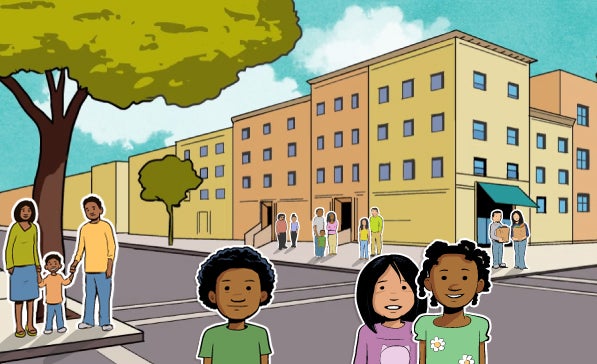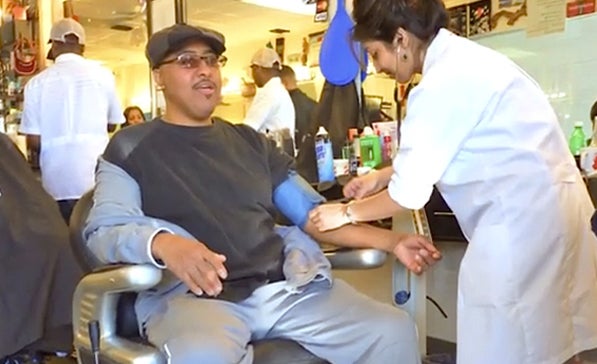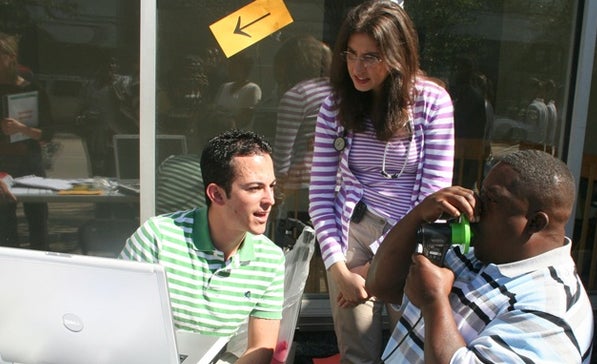What Can Research Do In Your Community?
Research takes place in many different settings.
Some research is done in clinical settings like a hospital or doctor’s office. Some may take place on a university campus. Other research happens in community settings where community members themselves may play a variety of roles in the research. This unit will present ideas about how you can get involved in research and work with researchers to improve the health and well-being of your community.
"It's going to take a community to really deal with these kinds of issues." - Dr. John Ruffin, Founding Director of the National Institute on Minority Health and Health Disparities (NIMHD)
Below are examples of how communities and researchers have been able to work together in the United States.
King County Healthy Homes, Seattle, WA
The King County Healthy Homes project was an intervention research project to help prevent asthma and encourage healthy indoor environments in Seattle.
The indoor home environment presents a range of health risks, including asthma triggers and exposures to toxics such as lead, pesticides, and volatile organics. Minority and low income populations are at increased risk for many of these exposures and children are most sensitive to their effects. Asthma is an important health consequence of these exposures, and its incidence and mortality appear to be steadily increasing, especially among low-income children.
The Seattle-King County Healthy Homes Project addressed these concerns. Paraprofessional Community Home Environmental Specialists (CHES) provided a comprehensive package of educational materials to reduce the total exposure burden of indoor environmental health risks. CHES conducted an initial home environmental assessment in low-income households with asthmatic children age 4-12. The home environmental specialists offered education and social support, encouraged behavior changes, provided materials to reduce exposures (bedding covers, vacuums, door mats, cleaning kits). This initial assessment was followed by five to nine visits over the next 12 months in which CHES worked with tenants, offering continued education and social support.
Community participation was an important component of this project. The project was developed by a partnership of community agencies, a tenant’s union, an environmental justice organization, the local health department, the CDC-sponsored Seattle Partners for Healthy Communities and the University of Washington. Primary funding was provided by the National Institute of Environmental Health Sciences with additional support from the Nesholm Foundation, the Seattle Foundation, and the Seattle-King County Department of Public Health. The project ran from 1997-2005 and found that the homes receiving the educational materials and supports had lower rates of development and severity of asthma in their children and higher awareness of how to prevent asthma.
Source http://www.kingcounty.gov/healthservices/health/partnerships/sphc/projects.aspx

Questions to think about and discuss when reviewing the four examples.
- Who did the study aim to help?
- What problem was the study trying to address?
- When did the study take place?
- How did researchers and community groups work together?
- How did the study make a difference in the community?

Healthy Mothers on the Move, Detroit, MI
The Healthy Mothers on the Move project aimed to demonstrate the effectiveness of a social support healthy lifestyle intervention designed to reduce risk factors for Type 2 diabetes among pregnant and postpartum women. The project worked with Latina and African American pregnant and post-partum women in Detroit. Two intervention programs were offered. One intervention was a Healthy Lifestyle Program with education and support for a healthy diet and exercise. A second intervention was a Pregnancy Control Program that taught stress management and provided general care support but did not include information or support for diet and exercise. Women’s Health Advocates from the community interacted with the study participants.
Among Latinas, there was almost 90% retention through pregnancy and more than 80% retention through six weeks postpartum. There was also high participant, Women’s Health Advocate, and host site satisfaction. Vegetable consumption in the Healthy Lifestyle group increased significantly. Other analyses are still ongoing.
Preliminary results suggest significant decrease in diabetes risk factors for the healthy lifestyle group. The Community Women’s Health Advocates were instrumental in conducting home visits and working with the women.
Source http://www.detroiturc.org/index.php?option=com_content&view=article&id=15&Itemid=28
Cervical Cancer Screening, Santa Clara, CA
Vietnamese-American women are five times more likely to develop cervical cancer than other American women. In Santa Clara, CA a REACH 2010 project aimed to increase Pap smear screening for early detection and prevention. The researchers ran a media campaign on the importance of screening in the community. The University of California also worked with the Vietnamese REACH Health Coalition and lay health workers to encourage Vietnamese Americans to get screened for cervical cancer. The study concluded that the women who spoke with the community health workers were more likely to get screened than the women who were exposed to the media campaign alone.
An evaluation of coalition programs showed that 47.7% of participants who had never had a Pap test received one after meeting with a lay health worker. The evaluation also showed that 17.9% of participants received a mammogram and 27.9% received a clinical breast exam after meeting with a lay health worker, compared with 3.9% and 5.1%, respectively, of women who did not meet with a lay health worker. In addition, 52.1% of participants had a repeat Pap test within 18 months, and 4,187 women enrolled in a reminder system. The study took place from 2004-2007 and involved 105,000 Vietnamese-American women.
Source http://www.ncbi.nlm.nih.gov/pmc/articles/PMC1494888/
WEACT Food Justice Initiative, New York, NY
The goals of the Food Justice Initiative are to understand the challenges and opportunities that children, parents, school officials and residents face regarding healthy food choices in school and at home through research. The WEACT Food Justice Initiative works with community residents in Northern Manhattan grassroots groups and other New York organizations to help influence and develop programs, laws and policies that affect access to healthy food in Northern Manhattan. WEACT has conducted surveys with community residents and schools. They are currently investigating the supply chain of public school lunches to better understand the ingredients and nutritional makeup of the food purchased by the New York City Public School system. One key portion of the Food Justice Initiative is educating policy makers on food justice issues and providing recommendations for improved policies at the City, State and Federal levels.
In addition, WEACT works at the community level to involve parents, students, teachers, the school board, school administrators, and the public in development of the local wellness policies at several Northern Manhattan schools. Since nearly all Northern Manhattan public school students are low-income, this is a critical window of opportunity to empower the community work together to influence policy for greater equality. WEACT educates and mobilizes the public school community to advocate for healthier policies at the NYC Board of Education, City Council, NYS Legislature and NYS Departments of Education and Health.
WEACT for Environmental Justice is a Northern Manhattan community-based organization whose mission is to build healthy communities by assuring that people of color and/or low-income participate meaningfully in the creation of sound and fair environmental health and protection policies and practices.
Source http://www.weact.org/Programs/EnvironmentalHealthCBPR/NorthernManhattanFoodJusticeInitiative/tabid/206/Default.aspx
Additional Resources
-
CDC Healthy Homes
-
Community Engaged Scholarship 4 Health
-
Community-Campus Partnerships for Health
-
Developing and Sustaining Community-Based Participatory Research Partnerships: A Skill Building Curriculum
-
Healthy Homes II Asthma Project
-
Healthy Mothers on the Move, Detroit, MI
-
King County Healthy Homes Project, Seattle, WA
-
REACH CDC Success Stories
-
REACH: The Power to Reduce Health Disparities
-
The Community Toolbox (University of Kansas)
Important Question
What could research do in your community?








